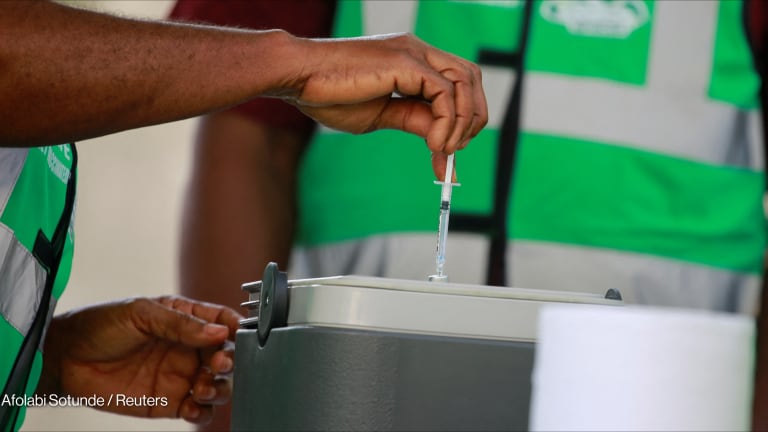Why one major NGO saw support fall by $1.6B
The Task Force for Global Health is one of the world's largest NGOs, but it has taken a billion-dollar hit to its revenue due to COVID-19.
The Task Force for Global Health is one of the world’s largest health NGOs, receiving most of its support in the form of in-kind donations. But over the past two years, those donations have taken a billion-dollar hit from COVID-19. In the fiscal year ending in August 2019, The Task Force received in-kind donations worth more than $2.5 billion — chiefly drugs to combat neglected tropical diseases, or NTDs. But those donations fell in value to about $847 million in fiscal 2020 and then rebounded slightly to $961 million in fiscal 2021 — still a drop of more than 60% from 2019. Its largest donors are pharmaceutical giants Pfizer, which in the last fiscal year provided $646 million worth of Zithromax to combat trachoma, and Merck, which donated $315 million worth of Mectizan to fight river blindness, according to the task force. But it also works on many other programs, including a relatively new partnership with Novartis to tackle leprosy, a disease that still sees hundreds of thousands of new cases each year. Not 100% of the change in funding was due to COVID-19, said Bill Nichols, head of operations at the task force. Part of it came down to success: As some diseases are brought under control, less medicine is needed. But the pandemic has had an impact. “COVID-19 has severely hit our supply chains and ability to deliver,” Nichols said. “Each of our programs has been affected differently. Overall, we think it’s set us back probably six to 12 months.” For several months, supply chains all but stopped, according to Carla Johnson, director of the supply chain at the International Trachoma Initiative, which manages trachoma-related donations and is housed at The Task Force. “For the later parts of 2020 and the early parts of 2021, we supplied very little at all,” she said. “Now, drugs are moving again, but it’s still not back to normal. In the next few years, demand may even rise above the normal levels, if countries decide to give catch-up doses [to those who missed treatments].” Procurement and forecasting Some challenges revolve around forecasting, procurement, and understanding what the need is. “Right now, forecasting is difficult,” Johnson said. “Usually we would have people in-country, doing prevalence surveys, taking samples, and looking at eyelids. But that has had to stop, so we are not getting accurate information about what is happening.” However, producing the supplies isn’t a problem, she said. “We source drugs from five continents. … As much as we can transport, they can make.” “We anticipate a year and a half or two years of knock-on effects [from the COVID-19 pandemic].” --— Carla Johnson, director of the supply chain, International Trachoma Initiative Transport is still an area of great difficulty, said Cassandra Holloway, a project support specialist at the Task Force. She supports the Neglected Tropical Diseases Supply Chain Forum, which brings together private suppliers, drug manufacturers, the World Health Organization, and NGOs to coordinate supply of drugs. “Airfreight has seen a substantial decline in cargo space,” Holloway said. “As a result, there is much more competition for the available space. We’ve seen a 50% increase in transportation cost. The cost of airfreight is up 77% since 2018.” The slowdown has also led to an increase in the cost of storage, with drugs spending weeks and months in factories and warehouses. And for relatively short-dated drugs — such as Zithromax, which has a relatively short shelf life — the threat is that they will no longer be usable by the time they can be transported again. Customs and borders COVID-19 has also created a patchwork of international border closures and limitations on the vessels that can enter particular ports. “We had a lot of situations where you had to unload the drugs off one ship and onto another, or you had to send it hundreds of miles in one direction and hundreds of miles back again,” Holloway said. And once treatments successfully reach a seaport or airport, they often face new restrictions. “We typically have delays in clearing customs,” Holloway said. “Some countries have more stringent regulations than others. But during the pandemic, there just weren’t the customs staff. There weren’t the people in ports to load and unload. You couldn’t get drugs across borders.” The NTD Supply Chain Forum was set up to share this information and help get drugs across borders, she said. Many different organizations involved in the supply of drugs have come together to problem-solve, allowing them to do so more effectively. The ‘last mile’ The part of transport known as the “last mile” — moving items from regional depots to district stores, pharmacies, and individuals — was the biggest barrier to delivery before the pandemic, Johnson said, and COVID-19 has exposed some further areas of weakness. “It showed us that we didn’t have a lot of visibility about where drugs were once they got in-country,” she said. “We already knew this was the case. They are called neglected diseases for a reason. A lot of the systems, as they get closer to the end of the line, are paper-based. It’s a shoestring budget. So we’re trying to develop systems to help.” Once supplies are within a country’s borders, Johnson said, the next step often involves dealing with local lockdowns or revising plans for administering vaccines in schools, if classrooms have been forced to close. “It’s going to get better in 2022,” she said, “but we anticipate a year and a half or two years of knock-on effects.”
The Task Force for Global Health is one of the world’s largest health NGOs, receiving most of its support in the form of in-kind donations. But over the past two years, those donations have taken a billion-dollar hit from COVID-19.
In the fiscal year ending in August 2019, The Task Force received in-kind donations worth more than $2.5 billion — chiefly drugs to combat neglected tropical diseases, or NTDs. But those donations fell in value to about $847 million in fiscal 2020 and then rebounded slightly to $961 million in fiscal 2021 — still a drop of more than 60% from 2019.
Its largest donors are pharmaceutical giants Pfizer, which in the last fiscal year provided $646 million worth of Zithromax to combat trachoma, and Merck, which donated $315 million worth of Mectizan to fight river blindness, according to the task force. But it also works on many other programs, including a relatively new partnership with Novartis to tackle leprosy, a disease that still sees hundreds of thousands of new cases each year.
This story is forDevex Promembers
Unlock this story now with a 15-day free trial of Devex Pro.
With a Devex Pro subscription you'll get access to deeper analysis and exclusive insights from our reporters and analysts.
Start my free trialRequest a group subscription Printing articles to share with others is a breach of our terms and conditions and copyright policy. Please use the sharing options on the left side of the article. Devex Pro members may share up to 10 articles per month using the Pro share tool ( ).
David Ainsworth is business editor at Devex, where he writes about finance and funding issues for development institutions. He was previously a senior writer and editor for magazines specializing in nonprofits in the U.K. and worked as a policy and communications specialist in the nonprofit sector for a number of years. His team specializes in understanding reports and data and what it teaches us about how development functions.








